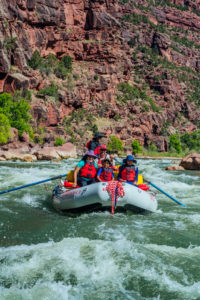Three Great River Adventures
3 BEST Rafting Trips in Utah/Colorado Northern Border
Northeastern Utah and the Colorado border are full of wonders to explore. As John Wesley Powell says, “We have an unknown distance yet to run, an unknown river to explore. What falls there are, we know not; what rocks beset the channel, we know not; what walls ride over the river, we know not. Ah, well! we may conjecture many things.”
- Gates of Lodore (Green River Section)
Time Commitment is typically 3-4 days
As you enter the narrow and dark maroon walls at the Gates; 4 days of changing scenery and geology are about to blow your mind. You are submitting yourself into the canyon that John Wesley Powell and his crew ventured into without knowing what was ahead. As you traverse the thrilling rapids with a skilled guide you will get to experience whitewater that is full of splashing water and a unique epic experience.
Between all the fun whitewater and chilling on the raft observing big horn sheep and other animals in nature. You can pull over and tie off the boat. Rippling Brook hike takes you to a small waterfall and then on the way back you can venture to the edge of a cliff where you can view the river looking upstream and downstream. The view is spectacular and will be something you won’t forget. This isn’t the only opportunity for side excursions. Your guides will help you explore the many intricate beauties of Lodore Canyon and all she has to offer.
- Yampa River (Designated Wild and Scenic)
Time Commitment is typically 4-5 days
As you leave the meanders of Deerlodge Park, the put-in for the Yampa River and enter the vast canyon of the wild and scenic chocolate river, you will find the magic and wonder of the place many guides call their summer office. The canyon walls will quickly bombard your mind with amazement. While every essence of your being is siphoned into the flow of the river moving forward in a constant swirling progression. The river will suck your soul in and the journey of how you fall in love with this sacred place has been set in motion. The desert daytime sun will be countered with coolish nights soaking in the cool breeze coming off the fresh runoff water from the Rocky Mountains. After day one you feel like maybe you know what to expect until you hit the long stretch of calm water and the Grand Overhang. Now it’s game on, where does all this slow moving water lead us…in no hurry at all?
The water all funnels into this narrow opening at the top of a rapid and not just any rapid. But THE rapid, that was formed by a landslide in ’65 and changed this canyon forever, Warm Springs! The rush of water gushing and gurgling as it bellows over the rock we call Maytag makes our experienced stomachs start to churn. The excitement and adrenaline pulse through our bodies and we wave to those left at the rivers’ edge waiting their turn. Double checking all the gear and reminding all to hang on, we slowly enter the tongue and then we are off and before we know it, we are screaming, cheering and maybe even cursing but we are making our way digging our oars in with every ounce of strength we can muster. Phew we made it and we throw our hands in the air and let out an elated, HELL YEAH!
And that’s not all. Don’t leave out all the cool stops to the Ancient Indigenous Artwork and granaries from the Fremont Culture. Taking this exhilarating ride will provide you with great food, entertainment, culture and all the natural wonder you could want in a 4-5 day trip.
The Gates of Lodore and the Yampa River are two escapes from the fast paced world that start and end near Vernal, UT and actually takes you through the heart of Dinosaur National Monument. Now that’s a place many don’t get to see!
- Green River A,B,C Section (Below Flaming Gorge Dam)
Time commitment is typically 1-3 days (or more if your heart desires)
These pieced out sections can be several one day trips or turned into a 2 night, 3 day excursion. This is hands down one of the most beautiful one day stretches around. Located below the Flaming Gorge dam, you put-in and can go. This is a great place to tackle some world class trout fishing and have some fun on a mellow low-key whitewater river. This scenic float along the Green River has some fun class 2 rapids perfect for an introduction to river rafting. Almost all ages can come and enjoy a day on the water. A picnic included can provide a chance to explore some of the small beaches and play in the cold water on a hot summer day.
The world class fishing alone brings thousands of people to visit and explore this section of the Green River every summer. A Utah one day river rafting trip is a great way to get out and adventure with the family if you aren’t quite committed to the high adventure of a longer 4 or 5 day trip. There are takeout’s between each section making it easy to lengthen or shorten your trip based on your needs.
I encourage those seeking a great thrill to consider these three options. It could be a time to escape the chaos of the world noise and enter the magic of nature through the veins and arteries that give the earth life and may be a renewal to yours.
-Kassie Robbins
